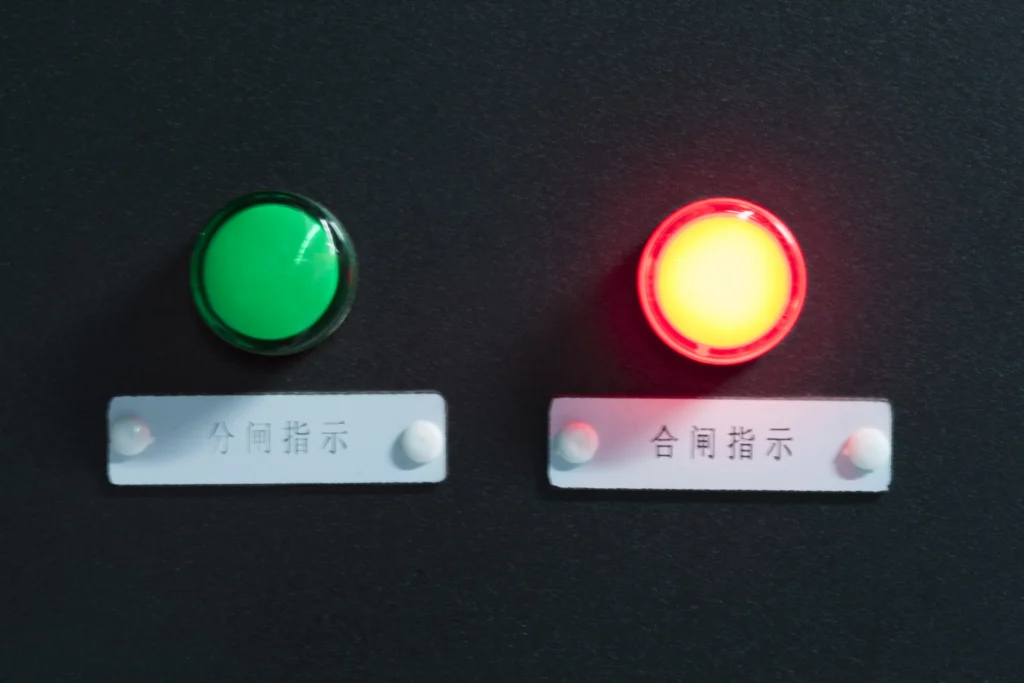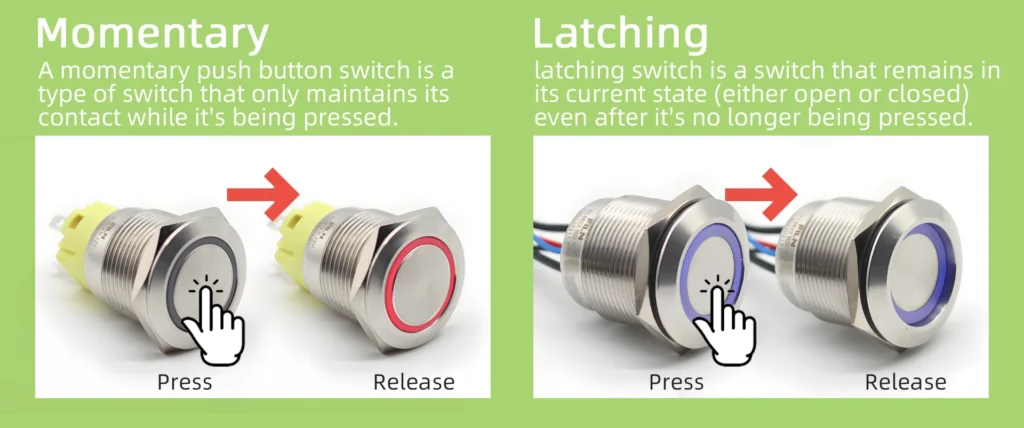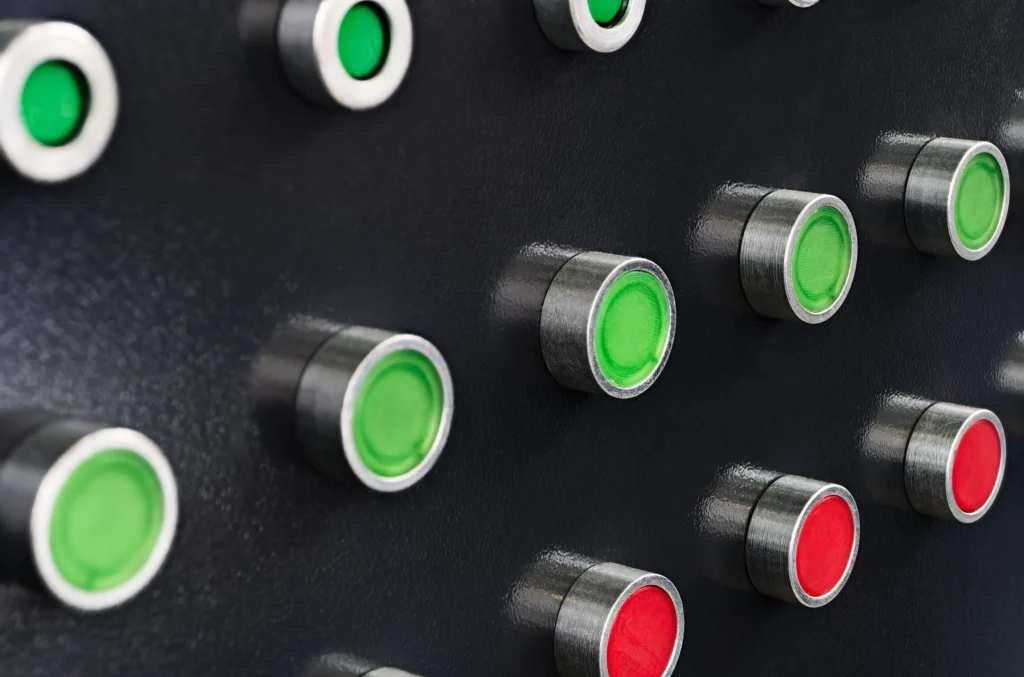The Momentary Switch plays a vital role in modern electronic devices. By activating only briefly, it offers precise control and is widely used in home appliances, industrial machinery, and smart systems.
This article explores the working principle, common types, and key factors for choosing the right Momentary Switch.
Whether you want to improve device responsiveness or ensure system safety, understanding Momentary Switches is essential.
What is a Momentary Switch?
A momentary switch, sometimes called a momentary contact switch, is a device that remains active only while being pressed. Once you release it, the switch automatically returns to its original “off” state. This is unlike a latching switch, which keeps its status until you change it manually. Momentary switches use a spring mechanism to reset their position as soon as pressure is removed.
What sets a momentary push button apart is its brief action. It’s designed to trigger a quick electrical signal or command for a short time, ideal for functions needing precise, moment-to-moment control. Commonly, these switches are found in devices like intercoms, doorbells, and lighting systems.
When you press the actuator (usually a button), it moves internal contacts together, completing the circuit and allowing current to flow. When you let go, a spring pushes the button back, breaking the circuit and stopping the current. This simple design provides reliable and temporary activation, perfect for tasks where only short bursts of input are needed.


How Does Momentary Switch Work?
Momentary push button switches function by briefly completing or breaking an electrical circuit. The switch mainly consists of two parts: an actuator (such as a button or lever) and electrical contacts connected via a spring mechanism. When you press the actuator, it physically forces the contacts together, closing the circuit and allowing electric current to flow.
The circuit stays active only while the button is held down, performing the intended action. Once you release the actuator, the spring pushes the contacts back to their original position, breaking the circuit and stopping the current flow. This design ensures that the switch is only “on” momentarily and returns automatically to “off” when released.
Inside such a switch, the spring provides the force to reset the button, while the contact points enable or interrupt the electrical flow depending on the button’s position. This setup is ideal for applications needing quick, precise control, like doorbells, intercoms, or control panels, where temporary activation is essential.


Types of Momentary Push Button Switch
Momentary push button switches come in several types, each designed based on shape, style, and function.
Waterproof Momentary Push Button Switch
This type is built to resist water and moisture, thanks to a sealed design that prevents liquid damage. It performs reliably even in wet or humid conditions, making it ideal for marine equipment, automotive controls, and outdoor devices where exposure to water is common.
Tactile Momentary Push Button Switch
Tactile switches give a noticeable click or snap when pressed, offering clear feedback that the switch has been activated. This feature helps avoid accidental presses and connects the user directly with the device. You’ll often find tactile switches in keyboards, gaming controllers, and remote controls, where precise input is important.
Illuminated or LED Momentary Push Button Switch
Similar to regular push buttons, these include a built-in LED light that shows when the switch is active. This lighting helps users see if the switch is on, especially in dark environments. They are often used in control panels and audio equipment for easy status recognition.
Soft Touch Momentary Push Button Switch
Unlike traditional switches, soft touch buttons respond to a light touch without needing to be pressed hard. This type offers a smooth and modern feel, commonly seen in smartphones, home automation systems, and other touch-sensitive devices.
| Type | Description | Common Applications |
|---|---|---|
| Waterproof Momentary Push Button Switch | Designed to resist water and moisture with a sealed build that prevents liquid damage. Works well in wet or humid environments. | Marine equipment, automotive controls, outdoor devices |
| Tactile Momentary Push Button Switch | Provides a clear click or snap feedback when pressed, confirming activation and preventing accidental presses. | Keyboards, gaming controllers, remote controls |
| Illuminated or LED Momentary Push Button Switch | Includes built-in LED lights to show when the switch is active. Useful for visibility in dark or low-light environments. | Control panels, audio equipment |
| Soft Touch Momentary Push Button Switch | Activates with a light touch rather than a firm press, offering a smooth, modern user experience. | Smartphones, home automation systems, touch devices |
Advantages of Momentary Switch
Momentary push button switches offer several compelling benefits:
1. Versatile
These switches are incredibly adaptable due to their compact size. They can fit into a wide range of devices, from small handheld gadgets to large control panels. This flexibility means momentary push buttons are useful in many different applications, including consumer electronics and industrial machinery. Their design allows for easy integration without compromising usability.
2. Space-Saving Design
Momentary switches are excellent for designs where space is limited. Their small physical size and the fact that they only create contact when pressed mean they take up very little room. This makes them ideal for applications like control panels, portable devices, and any equipment where maximizing space is important.
3. Cost-Effective
Momentary push buttons are often budget-friendly. Their simple design allows for efficient manufacturing, leading to lower production costs. This makes them more affordable than complex switch types, providing an economical solution for various applications without sacrificing performance.
4. Theft Prevention
Integrating momentary push buttons directly into devices or control panels adds a layer of security. Unlike easily removable parts, these buttons are not simple to detach without affecting the entire system. This feature is particularly useful in public areas or environments where unauthorized access is a concern, enhancing the overall security of the system.
5. Resilient Against High Voltage
Momentary push buttons are generally robust and can handle various voltage demands and short circuits. Their strong construction helps them withstand electrical stress. However, because they are compact, extreme voltage spikes or harsh conditions could still damage them. Proper usage and adherence to operational guidelines are essential for maintaining their reliable performance over time.
Applications of Momentary Push Button Switch
Momentary push button switches are widely used across different fields due to their quick and temporary activation properties. Here are some common applications:
- Intercoms:Momentary switches play a key role in intercom systems by enabling short-term communication. Pressing the button activates the intercom circuit, allowing users to speak and listen across different locations. This function is essential for secured entry points, room-to-room communication, and building-wide announcements.
- Home Appliances:Many household devices use momentary switches to control specific functions. For example, microwave ovens and washing machines rely on these switches to start, pause, or reset operations quickly. Their ease of use enhances user convenience during everyday tasks.
- Elevator Buttons:In elevators, momentary switches register floor selections. When pressed, the button sends a signal to operate the elevator accordingly. Because the switch only remains active while pressed, it ensures accurate command input without continuous engagement.
- HVAC Systems:Heating, ventilation, and air conditioning units utilize momentary switches to adjust settings like fan speed and temperature modes. Brief presses allow immediate, temporary changes, giving users direct control over their environment.
Additional applications include electronic keypads, security systems like doorbells and alarms, medical equipment, industrial machinery, and vehicle controls—where instant, precise input is critical for performance and safety.
These diverse uses highlight the importance of momentary push button switches in delivering responsive and reliable control in many daily and industrial scenarios.


How to Select the Best Momentary Switch?
Choosing the right momentary push button switch requires careful thought to ensure it meets your specific needs. Here are the key points to consider:
1.Type of Momentary Switch
First, decide which type fits your application best. Options include standard, illuminated, emergency stop, tactile, anti-vandal, waterproof, hinged, soft touch, or metal dome switches. Your selection should match the function, environment, and user experience you want to provide.
2.Material and Design
Look at the materials used in making the switch. Durable options like stainless steel, thermoplastics, or tough plastics offer longer life. Also, consider the switch’s shape, size, and appearance to ensure it suits your device or panel and delivers a comfortable user experience.
3.Size and Mounting
The switch size should fit well within your available space without affecting usability. Check the mounting type—panel mount, surface mount, or PCB mount—to make sure it integrates smoothly with your setup.
4.Durability
For heavy-use situations, pick switches built to withstand repeated pressing and tough conditions like dust, moisture, or temperature changes. Look for ones with a high cycle life rating to guarantee long-term reliability.
5.Electrical Specifications
Make sure the switch’s voltage and current ratings align with your circuit requirements. Some need to handle low voltage, while others require higher voltage capabilities depending on the application.
6.Feedback and User Experience
Consider the type of feedback users will get. Tactile switches offer a clear click sensation, improving confidence. Illuminated switches help in dark environments, and soft touch types provide a modern, touch-sensitive feel. Choose a switch that enhances usability and satisfies users.
| Factor | Description |
|---|---|
| Type of Momentary Switch | Choose the type that suits your application, such as standard, illuminated, emergency stop, tactile, anti-vandal, waterproof, hinged, soft touch, or metal dome. Select based on function, environment, and user experience. |
| Material and Design | Consider durable materials like stainless steel, thermoplastics, or tough plastics for longer life. Also evaluate the switch’s shape, size, and appearance to fit your device or panel and ensure comfortable user interaction. |
| Size and Mounting | Select a switch size that fits well in your available space without compromising usability. Check mounting options like panel mount, surface mount, or PCB mount for smooth integration. |
| Durability | For frequent use, choose switches designed to withstand repeated presses and harsh conditions like dust, moisture, or temperature changes. Look for high cycle life ratings to ensure long-lasting performance. |
| Electrical Specifications | Verify that voltage and current ratings match your circuit needs. Some switches are made for low voltage, while others support higher voltage applications. |
| Feedback and User Experience | Think about the feedback provided: tactile switches offer a satisfying click, illuminated switches improve visibility in the dark, and soft touch switches deliver a modern, touch-sensitive feel. Pick one that enhances usability. |
Conclusion
In conclusion, momentary switches offer precise and flexible control by connecting only while pressed. Their brief activation makes them valuable in many areas—from simple PC power buttons to complex industrial machines.
These switches combine compact design, durability, and electrical compatibility, making them a reliable choice for both designers and users.
If you need a quality, affordable momentary push button switch for your home or business, cantak provides durable options built to withstand tough conditions and last long. Reach out to us and find the perfect switch for your needs today!
Get the perfect momentary switch now!
<strong>Get your high-quality Momentary Switch today! Visit Langir to browse our collection and order with confidence.</strong>
FAQs
How to Wire a Momentary Switch?
To wire a momentary switch, start by identifying its terminals: common, normally open (NO), and normally closed (NC). Connect the positive (+) wire from the power source to the common terminal. Then, attach the device’s positive wire to the normally open terminal. Connect the negative (–) wire from the power source to the device’s negative wire. Pressing the switch completes the circuit and powers the device. Always check the switch’s datasheet to ensure proper wiring and polarity.
What is the Difference Between Momentary and Toggle Switches?
Momentary switches only stay active while pressed and return to their default state once released, making them ideal for temporary functions like doorbells. Toggle switches, on the other hand, maintain their on or off position until manually changed, which suits permanent control tasks such as turning devices on or off.
What is a Momentary Circuit?
A momentary circuit is a temporary electrical path that closes only briefly when a switch is pressed. Releasing the switch breaks the circuit. This type of circuit is common in applications that require short-duration actions, like doorbells and intercoms.
Is a PC Power Button a Momentary Push Button Switch?
Yes, the power button on a PC is usually a momentary switch. Pressing it sends a brief signal to the motherboard to start the computer. Once released, the circuit opens, but the computer stays on until the button is pressed again to turn it off.
What is the Voltage of a Momentary Push Button Switch?
Common voltages for momentary switches are 12 V and 15 V, but this can vary depending on the use case. It’s important to select a switch with a voltage rating that matches your circuit to ensure safe and reliable operation.

